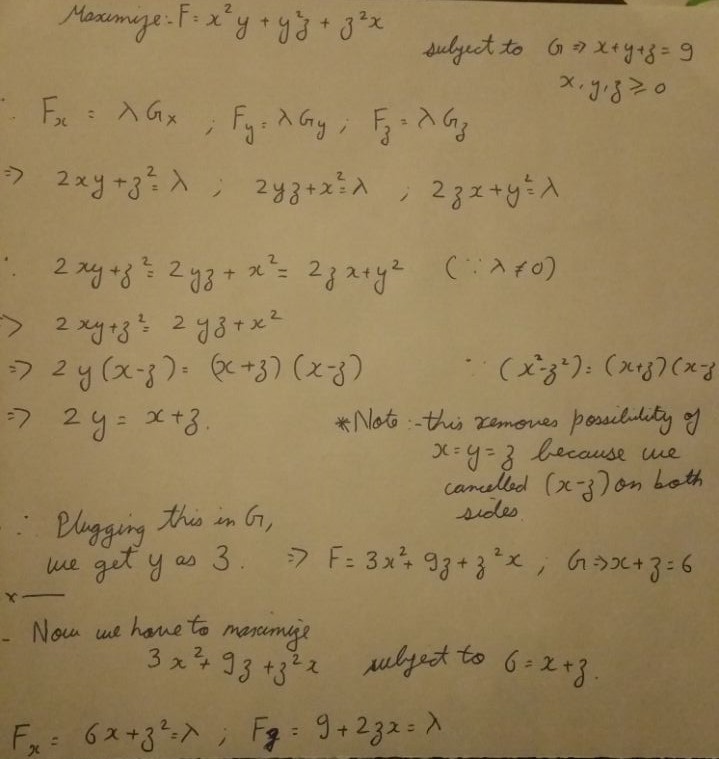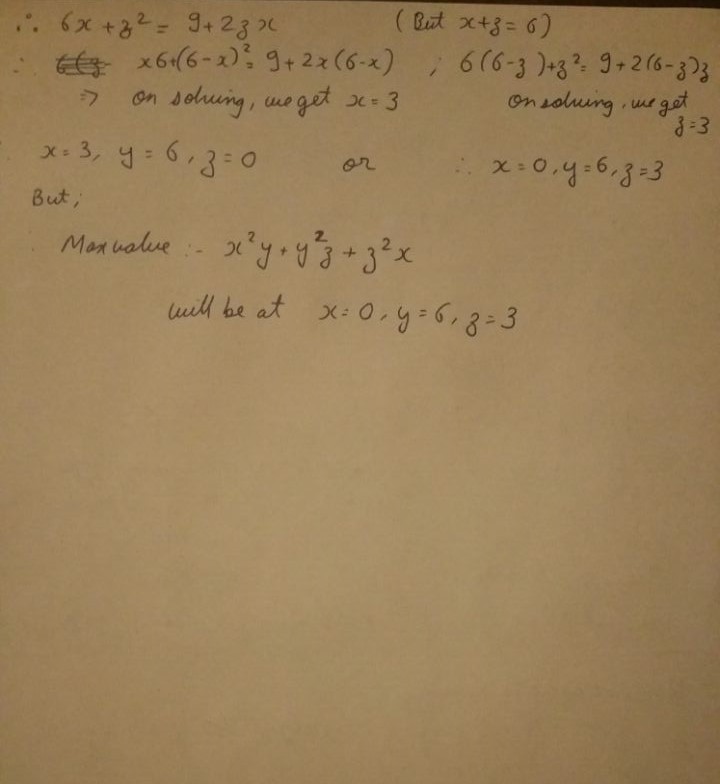Maksimum
x 2 y + y 2 z + z 2 x
If x , y , z are non-negative real numbers such that x + y + z = 9 , what is the maximum value of the expression above?
Give your answer to 2 decimal places.
The answer is 108.00.
This section requires Javascript.
You are seeing this because something didn't load right. We suggest you, (a) try
refreshing the page, (b) enabling javascript if it is disabled on your browser and,
finally, (c)
loading the
non-javascript version of this page
. We're sorry about the hassle.
3 solutions
There is a correction in the third line of the proof i.e. ≤ 2 7 ( x 2 y + x y z + x y z + z x )
Nice solution.
Wooowwwwww.
Write f ( x , y , z ) = x 2 y + y 2 z + z 2 x . In what follows, we assume that x , y , z ≥ 0 and that x + y + z = 9 . By symmetry, we can also assume that x ≥ y , z . Then f ( x , y , z ) − f ( x , z , y ) = x 2 y + y 2 z + z 2 x − x 2 z − z 2 y − y 2 x = ( y − z ) ( x 2 + y z − x y − x z ) = ( y − z ) ( x − y ) ( x − z ) and so we see that f ( x , y , z ) ≥ f ( x , z , y ) for x ≥ y ≥ z . Thus we see that f ( x , y , z ) will be maximised when x ≥ y ≥ z ≥ 0 . Since f ( x + z , y , 0 ) − f ( x , y , z ) = ( x + z ) 2 y − x 2 y − y 2 z − z 2 x = 2 x y z + y z 2 − y 2 z − z 2 x = y z ( x − y ) + x z ( y − z ) + y z 2 ≥ 0 for x ≥ y ≥ z ≥ 0 , we see that f ( x , y , z ) will be maximised when x ≥ y ≥ z = 0 . Thus we need to maximise f ( x , 9 − x , 0 ) = x 2 ( 9 − x ) 4 . 5 ≤ x ≤ 9 and this is maximised when x = 6 , giving us a maximum value of 1 0 8 .
Very nice, this is not x = y = z
Inequality Will oqqurs when 6 , 3 , 0
Mark, wondering if in the third last line it should be "we see that f ( x , y , 0 ) will be maximised..."
Log in to reply
No, the whole point of the previous arguments is that f ( x , y , z ) will be maximised when x ≥ y and z = 0 .
Log in to reply
OK. Sorry, I didn't read the x ≥ y ≥ z = 0 after that. Thanks a lot.
I used Lagrange multipliers for this. This uses partial differentiation


Don't hate me for using calculus to do an algebra problem
I am kind of suspicious of this approach though. Might need some corrections @Calvin Lin @Mark Hennings
This is incomplete.
You have only shown that the critical point occurs at (x,y,z) = (3,6,0) and (0,6,3), but how do you know that this critical point is a maximum point?
This is a pretty famous olympiad inequality problem, so let me present a classical inequality approach. There are actually several ways to tackle this, and this is my favorite (for reasons which you will see).
Proof: WLOG, let y be the middle number. Since ( y − x ) ( y − z ) ≤ 0 , thus y 2 + x z ≤ x y + z y . Then,
2 7 ( x 2 y + y 2 z + z 2 x + x y z ) = 2 7 [ x 2 y + x y z + z ( y 2 + z x ) ] ≤ 2 7 ( x 2 y + x y z + x y z + z 2 y ) = 2 7 y ( x + z ) 2 = 4 × 2 7 y × 2 x + z × 2 x + z ≤ 4 × ( y + 2 x + z + 2 x + z ) 3 = 4 ( x + y + z ) 3
For equality to hold, we need z ( y − x ) ( y − z ) = 0 and y = 2 x + z = 2 x + z .
This occurs when x = y = z or when z = 0 , x = 2 y . □
Applying this to the problem,
2 7 ( x 2 y + y 2 z + z 2 x ) ≤ 2 7 ( x 2 y + y 2 z + z 2 x + x y z ) ≤ 4 ( x + y + z ) 3
We have equality when z = 0 , x = 2 y (and cyclic permutations).